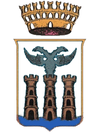Maratea
| Maratea | ||
|---|---|---|
| Comune | ||
| Città di Maratea | ||
 |
||
|
||
| Location of Maratea in Italy | ||
| Coordinates: 40°00′N 15°43′E / 40.000°N 15.717°E | ||
| Country | Italy | |
| Region | Basilicata | |
| Province / Metropolitan city | Potenza (PZ) | |
| Frazioni | Acquafredda, Brefaro, Castrocucco, Cersuta, Fiumicello, Marina, Massa, Santa Caterina, Porto | |
| Government | ||
| • Mayor | Domenico Cipolla | |
| Area | ||
| • Total | 67 km2 (26 sq mi) | |
| Elevation | 300 m (1,000 ft) | |
| Population (31 December 2013) | ||
| • Total | 5,205 | |
| • Density | 78/km2 (200/sq mi) | |
| Demonym(s) | Marateoti | |
| Time zone | CET (UTC+1) | |
| • Summer (DST) | CEST (UTC+2) | |
| Postal code | 85046 | |
| Dialing code | 0973 | |
| Patron saint | Saint Blaise | |
| Saint day | second Sunday in May | |
| Website | Official website | |
Maratea is a town and comune of Basilicata, in the province of Potenza. It is the only town of the region on the Tyrrhenian coast and because of its beautiful scenery and coastline it has been called "the Pearl of the Tyrrhenian". Owing to the considerable number of its churches and chapels it has also been described as "the town with 44 churches".
Maratea is the only town of Basilicata on the Tyrrhenian Sea. It has approximately 32 kilometres (20 miles) of rocky coastline, with more than twenty beaches. One of the main characteristics of Maratea is the variety of its landscapes, varying from breath-taking sea views to wooded hillsides and majestic mountains which sweep down to the sea creating steep cliffs.
The Grotta di Maratea, or the Cave of Wonders, was discovered in 1929 by men building the Highway 18 from Calabria.
The centre of the town (called Maratea Borgo, meaning "Maratea's Old Town") is situated on the northern slopes of Mount San Biagio; other villages in the comune include Acquafredda, Cersuta, Fiumicello, Porto, Marina, Castrocucco (situated on the coast), Castello, Santa Caterina, Massa and Brefaro (situated on the overlooking hills). The principal vegetation comprises oaks, pines, rosemary, holm oaks, carob trees and wild fennel.
Maratea has a small harbour, which can accommodate up to 200 boats.
Maratea probably derives from the fennel plant, which is called Marathéa/Μαραθέα in Medieval Greek, Marathía in Italiot Greek (as well as Marathiá/Μαραθιά in Modern Greek).
Based on archeological findings, the first settlements in the Maratea region date back to the Paleolithic era. In the 15th–14th century BC a village grew up on top of the little headland called La Timpa. This was a small trading center, and its existence is documented until the 2nd century BC, when the Romans conquered Lucania.
...
Wikipedia


